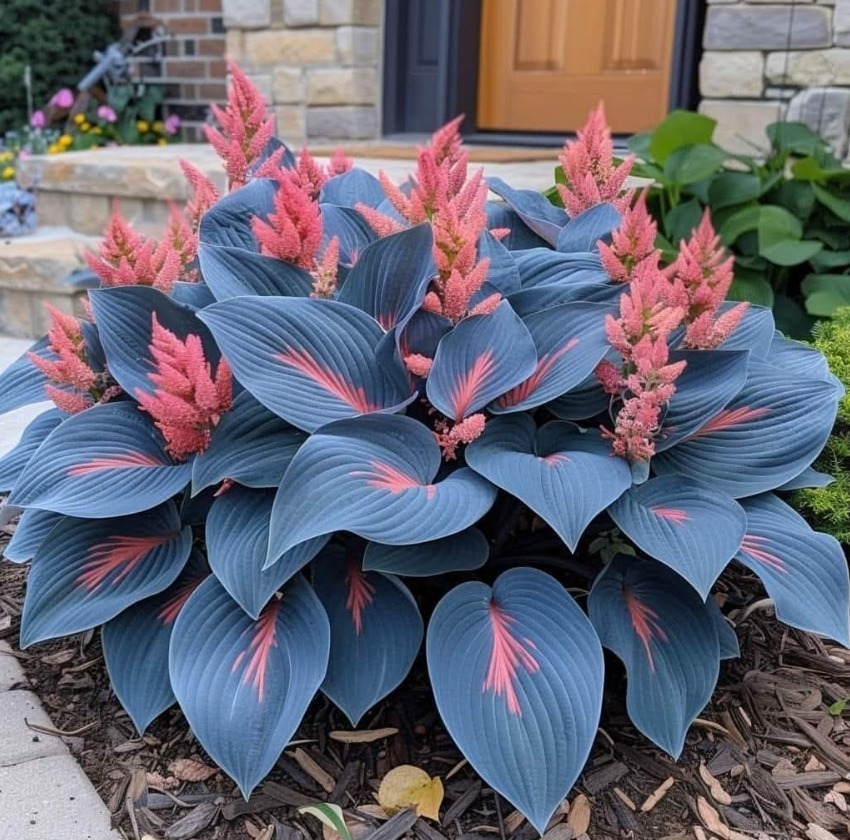
The Hosta plant is the undisputed queen of the shade garden, and for good reason. Its lush, architectural foliage can take a dark, forgotten corner of your yard and transform it into a vibrant, beautiful oasis.
From tiny, mouse-eared varieties that can fit in a teacup to giant, sculptural specimens that make a bold statement, there is a hosta for every space. This guide will cover everything you need to know to successfully grow these incredible perennials.
The Allure of the Hosta: More Than Just Green Leaves
The Hosta is a hardy, herbaceous perennial, which means it dies back to the ground in winter and returns each spring. Gardeners grow this plant almost exclusively for its incredible foliage.
While most hostas do send up graceful spikes of lavender or white flowers in the summer, the leaves are the real stars of the show. Their season-long color and form provide structure and beauty in shady spots where many other plants struggle to grow.

A World of Variety: Size, Color, and Texture


The true magic of the Hosta plant is its unbelievable diversity. There is a hosta to fit any garden design, with an incredible range of features to choose from.
- Size: Hostas can be tiny miniatures like the popular ‘Blue Mouse Ears’, perfect for containers, or they can be giant specimens like ‘Sum and Substance’, which can grow up to six feet wide.
- Color: You can find hostas in every shade of green, from bright chartreuse to deep forest green. They also come in stunning blues, brilliant golds, and creamy whites, with many variegated varieties showing off contrasting colors on the edges or center of the leaf.
- Texture: The leaves can be smooth and glossy, heavily puckered and corrugated for a “seersuckered” look, or have beautifully ruffled, wavy edges.
Planting Your Hosta for a Lush Landscape
Planting a hosta correctly sets it up for a long and beautiful life in your garden. The process is simple and straightforward, and getting it right from the start will ensure your plant thrives.
Finding the Perfect Spot: Sun or Shade?
This is the most important question for any hosta grower. Where do hostas grow best? The simple answer is in the shade. Most hostas thrive in dappled or partial shade, where they are protected from the hot afternoon sun which can scorch their leaves.
However, not all shade is the same, and the ideal amount of light depends on the type of Hosta plant you have:
- Blue Hostas: These need the most shade. Their beautiful blue color comes from a waxy coating that will melt away in direct sun, turning the leaves green.
- Gold and Yellow Hostas: These varieties can tolerate more sun. In fact, a bit of gentle morning sun often helps bring out their brightest gold colors.
- Fragrant Hostas: Many hostas with fragrant flowers can also handle more sun and heat than other types.
How to Plant a Hosta
The best time to plant hostas is in the spring or early fall. Begin by digging a hole that is wider than it is deep, giving the roots plenty of room to spread out.
Hostas love rich, well-draining soil, so mix a generous amount of compost into the soil you removed from the hole. Place the plant in the hole so that the crown—the part where the leaves meet the roots—is level with the surrounding ground. Backfill the hole with the amended soil, press it down gently, and water thoroughly to settle everything in place.
Essential Care for a Thriving Hosta Plant
Once established, the Hosta plant is famously low-maintenance. A few simple tasks during the growing season will keep your plants healthy, vibrant, and looking their absolute best.
Watering and Fertilizing
Hostas perform best when they receive consistent moisture. A good rule of thumb is to give them about an inch of water per week, either from rainfall or from your hose. Deep, thorough watering is better than frequent light sprinklings.
You can give your hostas a boost by feeding them in the spring just as their new shoots, or “pips,” are emerging from the ground. A single application of a balanced, slow-release granular fertilizer is all they need for the entire season.
Dividing Hostas for More Plants
Hostas are tough perennials that come back bigger and better every year. After a few years, you may notice the center of the clump looking a little thin or not producing as many leaves. This is a sign that it is time to divide your plant.
Dividing is best done in the spring. Carefully dig up the entire root ball and place it on a tarp. You can then use a sharp spade or a garden knife to slice the clump into smaller sections. Make sure each new section has at least one or two “eyes” or growing points. Replant these new divisions, and you will have more hostas to enjoy and share.
Protecting Your Hostas: Common Pests and Problems
While the Hosta plant is wonderfully easy to grow, it does have a few dedicated enemies in the garden. Knowing how to protect your plants from these common pests is the key to keeping their beautiful foliage looking perfect all season long.
The Battle Against Slugs and Snails

The number one pest for hostas is the slug. You will know they have been visiting when you see ragged, irregular holes chewed into the leaves. Fortunately, there are many ways to fight back.
You can set out shallow traps filled with beer or use a slug bait product. Look for baits that use iron phosphate, which is safe to use around pets and wildlife. Sprinkling diatomaceous earth around your plants can also help. For a natural solution, choose hosta varieties with thick, puckered leaves, as slugs tend to avoid these tougher textures.
Dealing with Deer and Other Critters
To a deer, a lush hosta garden looks like an all-you-can-eat salad bar. Deer absolutely love to eat hostas, often munching them right down to the ground.
If deer are a problem in your area, you will need to take protective measures. Regular applications of a deer repellent spray can be very effective. The most foolproof solution is a fence. Alternatively, you can grow your favorite hostas in containers on a protected deck or patio that deer cannot access.
FAQ: Your Hosta Plant Questions Answered
Here are clear, straightforward answers to some of the most common questions gardeners have about growing the beautiful and versatile Hosta.
Where do hostas grow the best?
Hostas grow best in a location that gets partial or dappled shade, with good protection from the hot afternoon sun. They thrive in rich, well-draining soil that is kept consistently moist. An ideal spot is under the canopy of high-branched trees or on the north side of your house.
Does hosta come back every year?
Yes, absolutely! The Hosta plant is a very tough and reliable herbaceous perennial. This means it will die back to the ground after the first hard frost in the fall but will return faithfully every spring, often emerging bigger and more beautiful than the year before.
Are hostas poisonous to dogs?
Yes, hostas are toxic to dogs, as well as to cats and horses. The plants contain compounds called saponins, which can cause vomiting, diarrhea, and loss of appetite if ingested. It is important to plant hostas in an area where your pets will not be tempted to eat them.
Does hosta need sun or shade?
Most hostas need shade to look their best. While they are famous as shade-loving plants, the very best location is one with bright, dappled shade rather than deep, dark shade. Some types have different needs; blue-leafed hostas need the most shade, while many gold and fragrant varieties can handle more morning sun.
Conclusion: The Indispensable Shade Garden Star
For any gardener blessed with shady areas, the Hosta plant is a truly indispensable and rewarding choice. Its incredible diversity in color, size, and texture means there is a perfect hosta for every garden design.
These plants are remarkably easy to care for and provide beautiful, architectural foliage from spring until the first frost. So, if you have a challenging, shaded spot in your landscape, look no further. A hosta is the elegant, season-long solution you have been searching for.

